Every culinary journey starts with a single ingredient. For me, that ingredient is kabocha squash. It’s a vibrant, nutrient-packed treasure from Chinese squash recipes kabocha vegan
Imagine a squash that can go from sweet to savory dishes. It’s so rich in nutrients, it becomes the star of your plant-based meals. Kabocha squash isn’t just a vegetable; it’s a canvas for your creativity in traditional Chinese cooking.
Key Takeaways
- Discover the nutritional powerhouse of kabocha squash
- Learn authentic Chinese vegan cooking techniques
- Explore easy-to-prepare squash recipes
- Unlock the versatility of plant-based Chinese cuisine
- Transform your meals with nutrient-dense ingredients
Introduction to Chinese squash recipes kabocha vegan
Discover the culinary magic of kabocha squash, a hidden gem in vegan recipes. It’s transforming plant-based Chinese cuisine. This vibrant winter squash brings incredible flavor and nutrition to healthy dishes, making it a star in vegan cooking.
What is Kabocha Squash?
Kabocha squash, known as Japanese pumpkin, is a unique winter squash. Its deep green exterior and bright orange flesh make it stunning in plant-based Chinese cuisine. When you explore what is kabocha squash in Chinese cooking, you’ll find it’s prized for its sweet, nutty flavor and creamy texture.
- Vibrant green skin with orange flesh
- Sweet and nutty flavor profile
- Creamy, smooth texture
- Versatile in various cooking methods
The Role of Squash in Chinese Cooking
Squash has been a cornerstone of traditional Chinese cuisine for centuries. Kabocha stands out as a versatile ingredient that absorbs flavors beautifully. Chefs love its ability to create rich, satisfying dishes that appeal to both vegetarian and vegan palates.
“Kabocha squash transforms ordinary meals into extraordinary culinary experiences” – Vegan Chinese Cuisine Expert
Why Vegan Chinese Recipes are on the Rise
The surge in vegan Chinese recipes reflects a growing global trend towards healthier, more sustainable eating. Kabocha squash perfectly embodies this movement, offering:
- High nutritional value
- Low-calorie content
- Rich in vitamins A and C
- Excellent source of dietary fiber
Your journey into vegan recipes starts with understanding this incredible ingredient. Kabocha squash isn’t just food—it’s a culinary adventure waiting to be explored.
Health Benefits of Kabocha Squash
Learn why kabocha squash is great for your health. This vibrant orange winter squash is full of benefits. It’s perfect for plant-based recipes.
Nutritional Powerhouse
Kabocha squash is a top choice for low-carb recipes. Here’s what you get in one cup:
- Only 49 calories
- 12 grams of carbohydrates
- 1.8 grams of protein
- Minimal fat content
Key Health Benefits
Yes, you can eat the skin of kabocha squash! It’s full of nutrients. Here are its health benefits:
| Nutrient | Benefit |
|---|---|
| Beta-Carotene | Supports eye health and immune function |
| Fiber | Improves digestion and supports blood sugar regulation |
| Vitamin A | Boosts skin health and vision |
Perfect for Vegan Nutrition
Kabocha squash is a star in vegan cuisine. It has a creamy texture and sweet flavor. It’s great for nutritious, plant-based meals.
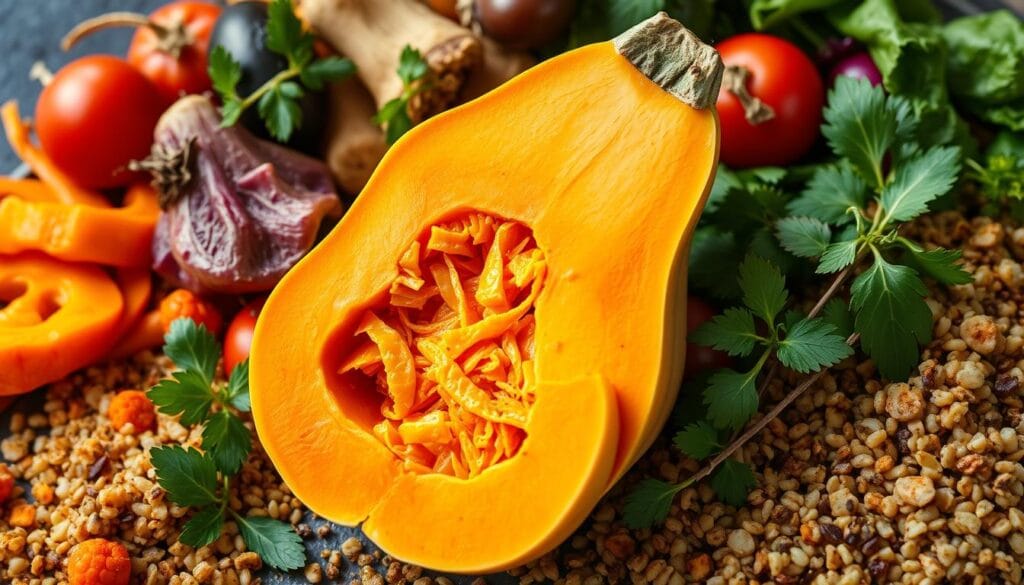
“Nature’s most delicious multivitamin comes in the form of kabocha squash!” – Nutrition Experts
Popular Chinese squash recipes kabocha vegan
Vegan Chinese cuisine is amazing with kabocha squash. These dishes mix old flavors with new ingredients. They make meals that are both tasty and memorable.
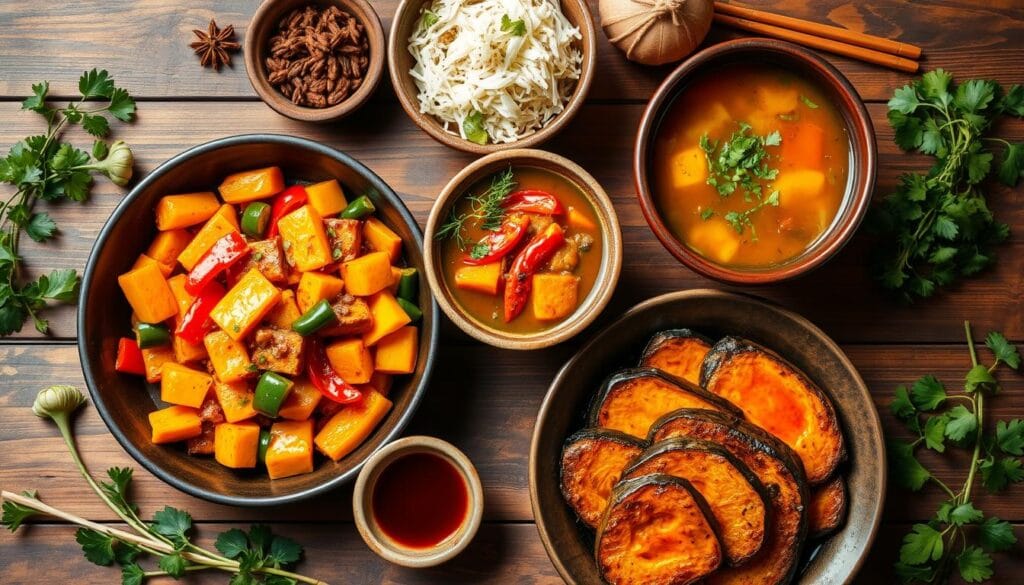
Kabocha Squash Stir-Fry Recipes
A classic stir-fry with kabocha squash is full of flavor and health. It’s a great vegan dish. It combines diced squash with colorful veggies and spices.
- Cubed kabocha squash
- Bell peppers
- Shiitake mushrooms
- Garlic and ginger
- Sesame oil
Steamed Kabocha Squash with Chinese Flavors
Steaming kabocha squash brings out its natural sweetness. Adding Chinese seasonings like five-spice powder makes it even better.
Soups Featuring Kabocha Squash
Kabocha squash soups are comforting and healthy. A mix of squash, coconut milk, and spices makes a delicious meal.
| Ingredient | Quantity |
|---|---|
| Kabocha Squash | 3 cups |
| Vegetable Stock | 4 cups |
| White Miso Paste | 1/4 cup |
| Mushrooms | 150.4 grams |
Unique Fusion Dishes Using Kabocha
Kabocha squash is great for making new dishes. From dumplings to roasted squash with chili sauce, these recipes are exciting.
“Kabocha squash transforms ordinary meals into extraordinary culinary experiences!” – Vegan Chinese Cuisine Expert
Step-by-Step Guide to Making Chinese squash recipes kabocha vegan
Starting with kabocha recipes for beginners is a fun journey. This guide will show you how to make tasty vegan Chinese-style squash dishes. Your kitchen will soon become a place of amazing flavors.
Essential Ingredients for Vegan Chinese Kabocha Recipes
First, collect these important ingredients for authentic Chinese-style squash cooking tips:
- Fresh kabocha squash
- Organic soy sauce
- Fresh ginger and garlic
- Firm tofu
- Scallions
- Sesame oil
- Rice vinegar
Preparing Kabocha Squash for Cooking
Do you peel kabocha squash before cooking? The good news is you don’t have to! The skin is safe to eat and full of nutrients. Here’s how to prepare it:
- Wash the squash well
- Cut it in half with a sharp knife
- Scoop out the seeds
- Slice it into shapes you like
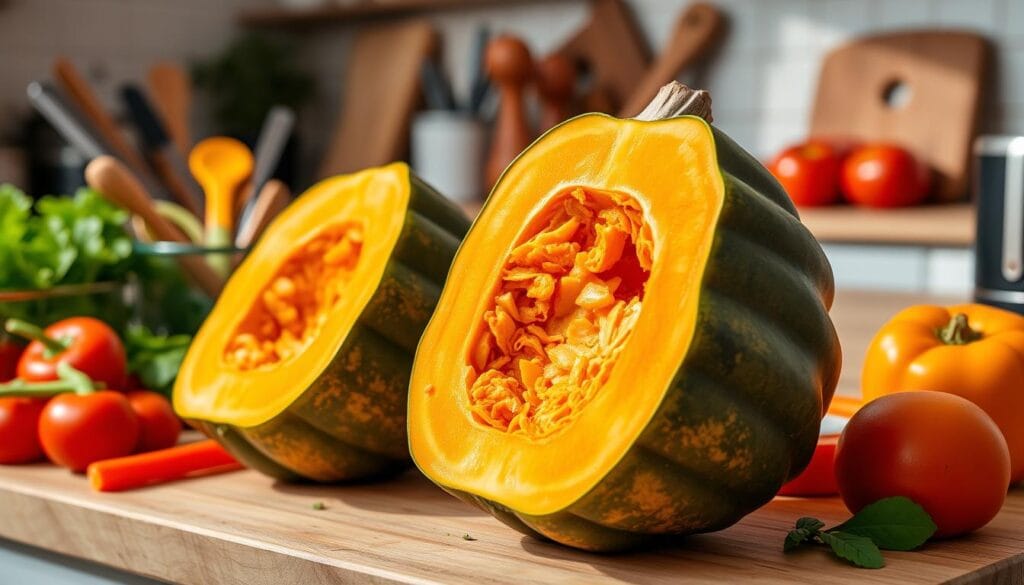
Three Detailed Vegan Recipes
Now, let’s look at three tasty kabocha recipes. They show how versatile this amazing squash is:
| Recipe | Preparation Time | Difficulty Level |
|---|---|---|
| Tofu Kabocha Stir-Fry | 20 minutes | Beginner |
| Creamy Kabocha Soup | 30 minutes | Intermediate |
| Steamed Kabocha with Soy Glaze | 15 minutes | Easy |
“Cooking is about passion, creativity, and love – specially with beautiful ingredients like kabocha squash!” – Vegan Chef Inspiration
These recipes will help you get better at Chinese-style squash cooking. You’ll enjoy healthy, delicious vegan meals.
Tips and Tricks for Perfect Chinese squash recipes kabocha vegan
Mastering autumn squash recipes means knowing the unique traits of each squash. Kabocha squash is special in Chinese cooking. It brings great flavor and health benefits.
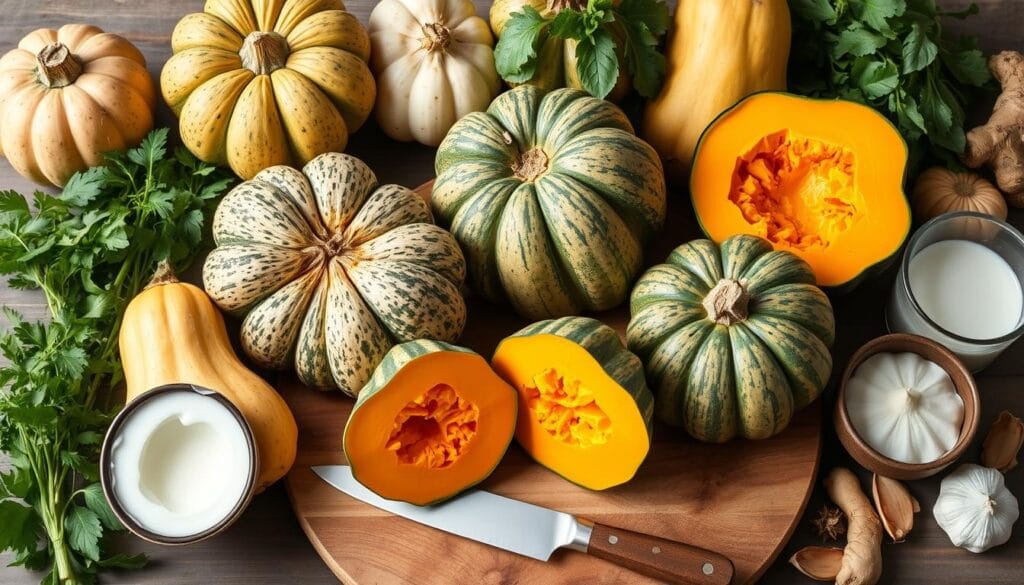
Selecting the Perfect Kabocha Squash
Here’s what to look for in a kabocha squash:
- Smooth, firm skin with no soft spots
- Heavy for its size
- Deep green or dark orange color
- No visible blemishes or wrinkles
Avoiding Common Cooking Mistakes
Knowing the difference between butternut and kabocha squash is key. Kabocha is denser and sweeter. It needs special cooking:
- Avoid overcooking, which makes the squash mushy
- Season generously to enhance natural flavors
- Use appropriate cooking methods
Enhancing Flavor with Chinese Spices
Make your kabocha dishes pop with these Chinese cooking tips:
| Spice | Flavor Profile | Best Pairing |
|---|---|---|
| Five-spice powder | Complex, warming | Roasted kabocha |
| Star anise | Sweet, licorice-like | Steamed squash |
| Sichuan peppercorns | Numbing, spicy | Stir-fried kabocha |
“The secret to perfect kabocha is respecting its natural sweetness while adding depth through carefully selected spices.”
Pro tip: Roast or steam kabocha to keep its nutrients and sweetness. Mix it with ginger, garlic, soy sauce, and sesame oil for a true Chinese vegan dish.
FAQs about Chinese squash recipes kabocha vegan
Explore the most common questions about kabocha squash and its use in vegan cooking. Whether you’re an experienced chef or just starting, these tips will guide you through the tasty world of this unique squash.
Can I Substitute Kabocha Squash with Other Types?
When comparing butternut squash and kabocha squash, you’ll notice differences. Butternut squash is lighter and more watery, while kabocha is denser and sweeter. You can swap them in most recipes, but the taste and texture will vary slightly.
- Butternut squash: Lighter and more neutral flavor
- Kabocha squash: Sweeter and more intense taste
- Acorn squash: Another potential alternative with similar dense texture
Do You Eat the Skin of Kabocha Squash?
Good news for squash fans! Yes, you can eat the skin of kabocha squash. It’s not only safe but also full of nutrients and fiber. When cooked, it becomes soft and adds a nice texture to your meals. Just make sure to wash it well before cooking.
How to Store Cooked Kabocha Squash Dishes?
Keeping your vegan kabocha dishes fresh is key. Store cooked kabocha in airtight containers in the fridge for up to 4 days. For longer storage, freeze for up to 3 months. A helpful tip: Freeze in individual portions for easy reheating.
What Are Some Vegan-Friendly Chinese Sauces?
Boost your kabocha dishes with these tasty vegan Chinese sauces:
- Hoisin sauce
- Plum sauce
- Sweet and sour sauce
- Chili sauces
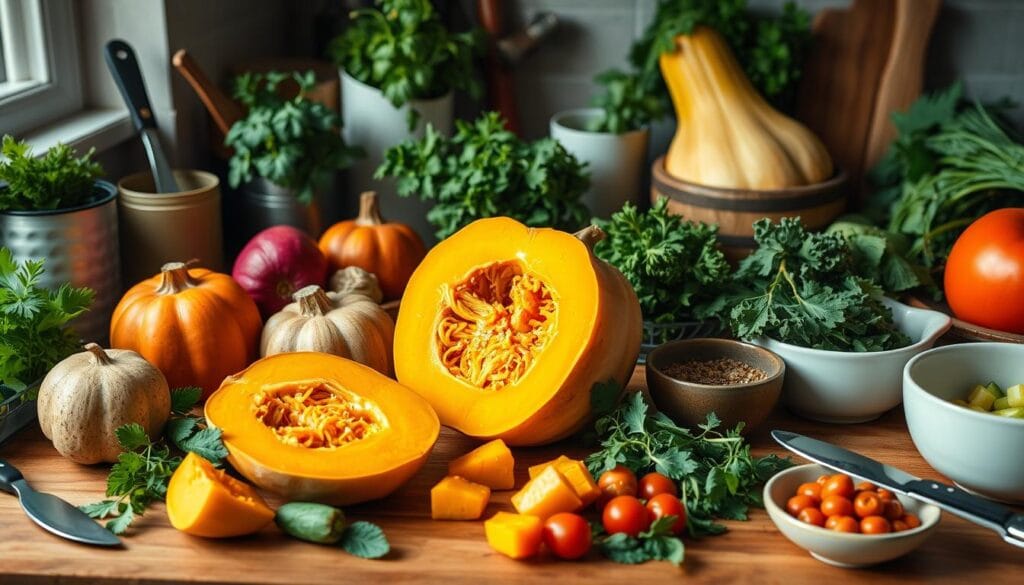
“Cooking is about exploration, and kabocha squash opens up a world of delicious vegan possibilities!” – Vegan Cuisine Expert
FAQ
What is kabocha squash?
Can you eat the skin of kabocha squash?
How is kabocha squash different from butternut squash?
What are some popular ways to cook kabocha squash in vegan Chinese cuisine?
How do I store cooked kabocha squash?
What are some vegan-friendly Chinese sauces to use with kabocha squash?
Can I use other squash varieties instead of kabocha?
Conclusion and Inspiration for Your Next Meal
Your journey into vegan recipes doesn’t stop here. Kabocha squash opens a door to plant-based Chinese dishes. These recipes turn simple ingredients into amazing meals.
Kabocha recipes are great for beginners. They are easy to make and full of nutrients. With a few basic steps, you can make meals that taste like they’re from a restaurant.
Exploring these recipes makes your kitchen a place of endless flavors. Kabocha squash is packed with antioxidants and vitamins. It’s a key to making plant-based eating fun and healthy. Start cooking today and discover delicious, healthy meals.
Encouraging Culinary Exploration
Don’t be shy to try new spices, cooking ways, and mix-ins. Each recipe is a chance to grow your skills and taste in vegan Chinese food.
Celebrating Culinary Creativity
Think of cooking as an art. Your special touch can make these recipes your own. They can show off your taste and health goals.


1 thought on “Chinese squash recipes kabocha vegan”
Comments are closed.